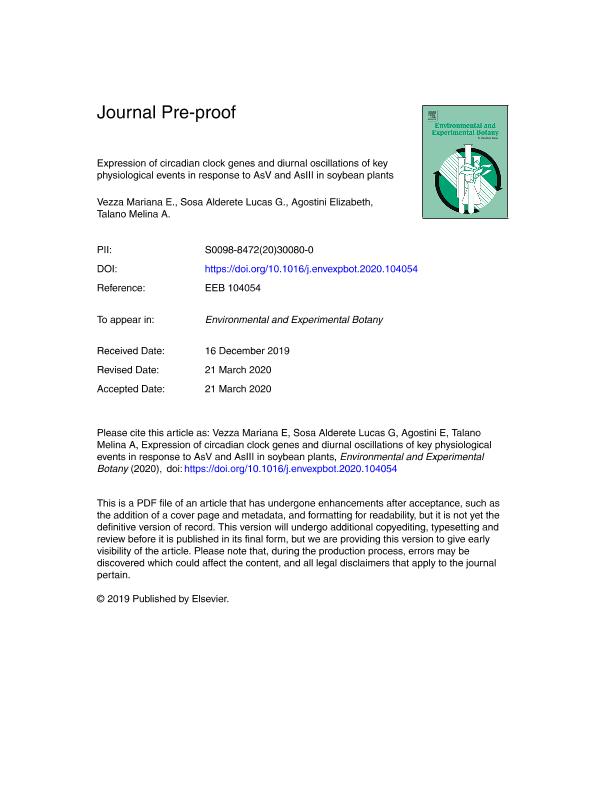Mostrar el registro sencillo del ítem
dc.contributor.author
Vezza, Mariana Elisa

dc.contributor.author
Sosa Alderete, Lucas Gastón

dc.contributor.author
Agostini, Elizabeth

dc.contributor.author
Talano, Melina Andrea

dc.date.available
2021-10-27T12:12:34Z
dc.date.issued
2020-06
dc.identifier.citation
Vezza, Mariana Elisa; Sosa Alderete, Lucas Gastón; Agostini, Elizabeth; Talano, Melina Andrea; Expression of circadian clock genes and diurnal oscillations of key physiological events in response to AsV and AsIII in soybean plants; Pergamon-Elsevier Science Ltd; Environmental and Experimental Botany; 174; 6-2020; 1-23
dc.identifier.issn
0098-8472
dc.identifier.uri
http://hdl.handle.net/11336/145196
dc.description.abstract
Soybean (Glycine max L.) is often cultivated in soils with a high content of arsenic (As). Since this greatly affects crop growth and yield, the response mechanisms underlying tolerance to As should be well understood. Circadian rhythms are known to play a central role in plant adaptation to stressful conditions. Therefore, our aim was to evaluate the effects of arseniate (AsV) and arsenite (AsIII) on the expression of key circadian clock genes (CG) and on the possible diurnal oscillation of physiological events induced by As in soybean plants. Leaves and roots were evaluated during light-dark phases at 4-h intervals. The changes caused by As in the expression profiles of all CGs analyzed depended on its chemical form and the plant organ involved. Overexpression of GmLCL1, GmTOC1, GmPRR9 and GmGI was observed in leaves mainly upon AsV-treatment, while underexpression of GmLCL1 and overexpression of GmPRR9, GmELF4 and GmGI occurred in roots, mainly upon AsIII-treatment. Moreover, As seemed to have an influence on the daily fluctuations observed in events triggered in response to the stress, such as stomatal aperture control, phytochelatin (PC) and glutathione (GSH) content, and total antioxidant, ascorbate (APx) and glutathione peroxidase (GPx) activities. In particular, the increase in the synthesis of PCs (the main As chelators) and the decrease in their precursor, GSH, were higher during the light phase, while APx and GPx activities increased during the dark phase in As-treated plants. The results suggest a link between the circadian clock and the response to As in soybean plants, since exposure to As modified CG expression and induced important changes in the diurnal oscillation of several As-response mechanisms. Circadian clock regulation, then, might play a vital role in the tolerance to As.
dc.format
application/pdf
dc.language.iso
eng
dc.publisher
Pergamon-Elsevier Science Ltd

dc.rights
info:eu-repo/semantics/openAccess
dc.rights.uri
https://creativecommons.org/licenses/by-nc-sa/2.5/ar/
dc.subject
ANTIOXIDANT SYSTEM
dc.subject
ARSENIC
dc.subject
CIRCADIAN CLOCK GENES
dc.subject
PHYTOCHELATINS
dc.subject
SOYBEAN
dc.subject.classification
Bioquímica y Biología Molecular

dc.subject.classification
Ciencias Biológicas

dc.subject.classification
CIENCIAS NATURALES Y EXACTAS

dc.title
Expression of circadian clock genes and diurnal oscillations of key physiological events in response to AsV and AsIII in soybean plants
dc.type
info:eu-repo/semantics/article
dc.type
info:ar-repo/semantics/artículo
dc.type
info:eu-repo/semantics/publishedVersion
dc.date.updated
2021-09-06T16:46:47Z
dc.journal.volume
174
dc.journal.pagination
1-23
dc.journal.pais
Estados Unidos

dc.description.fil
Fil: Vezza, Mariana Elisa. Universidad Nacional de Río Cuarto. Facultad de Ciencias Exactas Fisicoquímicas y Naturales. Instituto de Biotecnología Ambiental y Salud - Consejo Nacional de Investigaciones Científicas y Técnicas. Centro Científico Tecnológico Conicet - Córdoba. Instituto de Biotecnología Ambiental y Salud; Argentina
dc.description.fil
Fil: Sosa Alderete, Lucas Gastón. Universidad Nacional de Río Cuarto. Facultad de Ciencias Exactas Fisicoquímicas y Naturales. Instituto de Biotecnología Ambiental y Salud - Consejo Nacional de Investigaciones Científicas y Técnicas. Centro Científico Tecnológico Conicet - Córdoba. Instituto de Biotecnología Ambiental y Salud; Argentina
dc.description.fil
Fil: Agostini, Elizabeth. Universidad Nacional de Río Cuarto. Facultad de Ciencias Exactas Fisicoquímicas y Naturales. Instituto de Biotecnología Ambiental y Salud - Consejo Nacional de Investigaciones Científicas y Técnicas. Centro Científico Tecnológico Conicet - Córdoba. Instituto de Biotecnología Ambiental y Salud; Argentina
dc.description.fil
Fil: Talano, Melina Andrea. Universidad Nacional de Río Cuarto. Facultad de Ciencias Exactas Fisicoquímicas y Naturales. Instituto de Biotecnología Ambiental y Salud - Consejo Nacional de Investigaciones Científicas y Técnicas. Centro Científico Tecnológico Conicet - Córdoba. Instituto de Biotecnología Ambiental y Salud; Argentina
dc.journal.title
Environmental and Experimental Botany

dc.relation.alternativeid
info:eu-repo/semantics/altIdentifier/doi/https://doi.org/10.1016/j.envexpbot.2020.104054
dc.relation.alternativeid
info:eu-repo/semantics/altIdentifier/url/https://www.sciencedirect.com/science/article/abs/pii/S0098847220300800
Archivos asociados
